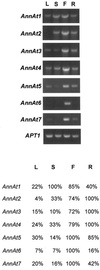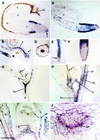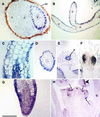Differential expression of members of the annexin multigene family in Arabidopsis
- PMID: 11457958
- PMCID: PMC116464
- DOI: 10.1104/pp.126.3.1072
Differential expression of members of the annexin multigene family in Arabidopsis
Abstract
Although in most plant species no more than two annexin genes have been reported to date, seven annexin homologs have been identified in Arabidopsis, Annexin Arabidopsis 1-7 (AnnAt1--AnnAt7). This establishes that annexins can be a diverse, multigene protein family in a single plant species. Here we compare and analyze these seven annexin gene sequences and present the in situ RNA localization patterns of two of these genes, AnnAt1 and AnnAt2, during different stages of Arabidopsis development. Sequence analysis of AnnAt1--AnnAt7 reveals that they contain the characteristic four structural repeats including the more highly conserved 17-amino acid endonexin fold region found in vertebrate annexins. Alignment comparisons show that there are differences within the repeat regions that may have functional importance. To assess the relative level of expression in various tissues, reverse transcription-PCR was carried out using gene-specific primers for each of the Arabidopsis annexin genes. In addition, northern blot analysis using gene-specific probes indicates differences in AnnAt1 and AnnAt2 expression levels in different tissues. AnnAt1 is expressed in all tissues examined and is most abundant in stems, whereas AnnAt2 is expressed mainly in root tissue and to a lesser extent in stems and flowers. In situ RNA localization demonstrates that these two annexin genes display developmentally regulated tissue-specific and cell-specific expression patterns. These patterns are both distinct and overlapping. The developmental expression patterns for both annexins provide further support for the hypothesis that annexins are involved in the Golgi-mediated secretion of polysaccharides.
Figures





References
-
- Barton GJ, Newman RH, Freemont PS, Crumpton MJ. Amino acid sequence analysis of the annexin super-gene family of proteins. Eur J Biochem. 1991;198:749–760. - PubMed
-
- Bauer B, Engelbrecht S, Bakker-Grunwald T, Scholze H. Functional identification of α1-giardin as an annexin of Giardia lamblia. FEMS Microb Lett. 1999;173:147–153. - PubMed
Publication types
MeSH terms
Substances
Associated data
- Actions
- Actions
LinkOut - more resources
Full Text Sources
Other Literature Sources
Molecular Biology Databases

